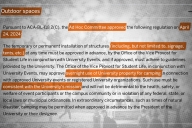You have /5 articles left.
Sign up for a free account or log in.

erhui1979/Digitalvision Vectors/Getty Images
We recently wrote an article for Inside Higher Ed about the challenges of a hidden curriculum that graduate students, especially those from historically excluded groups, must navigate. In that piece, we offered advice about networking, mentoring up and career planning. In this second essay, we will explore other aspects of dealing with the hidden curriculum—notably social identity, peer relationships, self-advocacy and accessing resources—in hopes of providing context and support for those who are just now encountering this curriculum.
You should first know that you are not alone. As one of us, Aurora, matriculated through graduate school, it was both comforting yet disheartening to learn that many graduate students, especially those of color across various graduate programs, were experiencing the same things and grappling with the same challenges. That realization inspired her to create a podcast platform, “Voicing Black Experiences,” for Black students to share their journeys in academe and medicine, as well as to create a repository of ways to overcome the barriers they were confronting. The podcast features many accounts of trials and successes in academic spaces.
Identity and Academic Culture
For graduate students, peers can help to better understand often unstated expectations of mentors, professors and the academic culture, including things like quality and approach of work and time management. One of the lessons that Aurora found to be particularly interesting about the hidden curriculum as a graduate student was the need to join cliques in the classroom. Naturally, people self-segregate by differences—Beverly Daniel Tatum does a marvelous job at explaining the history of this behavior and how it shows up in all stages of life in Why Are All the Black Kids Sitting Together in the Cafeteria?
But this self-segregating behavior can be a problem for students from historically excluded groups because it prevents them from benefiting from opportunities for broader peer mentoring. For example, due to self-segregating behavior, students from historically excluded groups may not be invited to participate with students from other backgrounds in study groups. Or the professor may share educational resources for the class with individual students and study groups composed primarily of historically included persons, leaving the underrepresented students without access. This clique behavior may exist within cohorts or across entire programs, which makes learning how to join a group with which you do not naturally identify, without compromising your own identity and beliefs, even more important.
Graduate students who are not included in classroom or cohort cliques due to self-segregating by social identities should consider relying on others who are more experienced for advice. For instance, older students may have a better understanding of how to integrate naturally with other peer groups, join study groups, identify strategies that fit one’s learning style and understand professors’ expectations of students, which can differ by the type of institution. In fact, research suggests that doctoral students often receive instrumental and psychosocial support from postdocs in their labs.
In addition, learning more about your own personality can help with interacting and connecting with people with different social identities. Self-reflection and personality assessments can provide insight to your own preferences for communication and collaboration. For instance, it may be helpful to take a personality test like the Myers-Briggs Type Inventory, CliftonStrengths assessment or Enneagram personality test and reflect on what feels most comfortable for you.
For example, naturally introverted people often won’t approach a group of people and strike up a conversation. Aurora, who is one of those people, found an effective strategy is simply to intentionally identify someone who seems approachable to ask a question about something you don’t understand. On the flip side, once you learn to be more comfortable doing so, you should be sure to pay it forward to help others. If someone is struggling with concepts, offer resources that could be helpful. These small interactions can lead to a conversation that helps illuminate the hidden curriculum—you might end up comparing notes on tough course topics, as well as sharing helpful resources or invitations to participate in study sessions. Learn more on Aurora’s podcast Traversing Diverse Academic Cultures.
Self-Advocacy
Being your own advocate is a life skill that gets better with practice. Graduate students from historically excluded groups have to ask for what they need, which can be difficult, especially when also facing microaggressions and the implicit biases of others that could cause harm. Addressing such issues requires having uncomfortable and sometimes difficult conversations with administrators, mentors and peers. Such interactions can be emotionally exhausting, and it takes time to prepare, have and process them, as they can differentially impact students from historically excluded groups dealing with microaggressions.
Navigating difficult conversations can be stressful, but techniques from Crucial Conversations can help make it less scary, especially in navigating the power differentials often present in academic settings—whether between principal investigators and students, administrators and students, or majority group peers and students from historically excluded groups. Leaning on a supportive community of mentors and peers can further help graduate students navigate such conversations. For example, students and postdocs may find it valuable to seek out additional mentors via national organizations like the National Research Mentoring Network, the National Black Postdoc Association, STEM Noire and VanguardSTEM, along with finding virtual communities (such as #BlackInSTEM and #BlackInMicro on Twitter), which seek to help individuals self-advocate for themselves.
You can also reach out to affinity groups at your own institution to provide support and connection. (For more tips, check out Navigating Difficult Conversations or Career/Field Transitions.) Especially for people from historically excluded groups, finding a community of people who share social identities and lived experiences can go a long way toward creating feelings of belonging and comfort.
Accessing Academic Resources
It can be difficult as a grad student to know where to start to look for assistance, especially when campus services aren’t centralized, so we have compiled a list of offices and programs that support trainees in their graduate training.
- Professional and career development programs (workshops, internships, training opportunities, career centers)
- Diversity, equity and inclusion offices and programs (identity trainee/student groups, centers)
- Accessibility resources (e.g., ADA) and neurodiverse trainee support (ADHD coaching)
- Counseling and psychological services (one-on-one psychological support, identity group support groups and group counseling, such as BIPOC, student parents, LGBTQIA+)
- Social support and networking opportunities (socials, activities, recreational events, student-led groups)
- Graduate and postdoctoral offices
We acknowledge that stigmas can be attached to accessing much-needed resources, whether in the form of internal pressure (thinking, “I am strong, I shouldn’t need help, I can handle this on my own”) or external pressures, like the risk of actual or perceived negative judgement by one’s peers, community, culture or family. (See the writings of the other author of this piece, Beka, about accessing mental health resources and some common barriers to doing so.) As a result, many graduate students are hesitant to seek out those resources, but we strongly encourage you to pursue them when needed.
Advocating as Training Professionals
As with other hidden curriculum aspects, academic program directors should look for opportunities to create programming that addresses the challenges of the hidden curriculum and offers graduate students actionable strategies for moving through academic and social settings. This could be through the Leadership Alliance programs, Initiative for Maximizing Student Development, a Postbaccalaureate Research Education Program and other programs that explicitly include community building and recommend specific ways to operate in academic and research environments.
When students have to opt in to these sessions, programs risk losing the opportunity to share the information with those who don’t know to opt in. So embedding programming into required programs where all students will be exposed to and know about resources, such as orientation programs and formal parts of the curriculum, can be a valuable method to help make sure no students fall through the cracks. Another option is to create programming explicitly tailored for historically excluded groups that includes discussions of potential barriers experienced by participants, along with ideas for overcoming them. Explicitly inviting people in so they know the conversation is meant for them can also be a powerful tool.
Program directors and administrators can also help trainees by creating visibility around campus resources and normalize their usage—acknowledging that developing self-awareness around and advocating for one’s needs during training is important and necessary, and that accessing support programs is encouraged and accepted for all students to thrive. Of course, removing barriers to access and disseminating knowledge about programs to support trainees can be just as important as advocating for and creating new resource and programs that can build skills that are valuable for their trainees. Training professionals should be actively pursuing both options.
Concluding Thoughts
Navigating peer relationships in an unfamiliar academic environment, building the confidence to self-advocate and gain what each person needs from their own training experience, and normalizing use of resources on campus to support trainees are all key ways to advance in the academic research education and training environment. If you are a graduate student, especially one from historically excluded groups, we hope you will consider pursuing some of the paths we’ve suggested that seem most helpful to you.
We also hope this article and our preceding one will inspire those who have already traversed graduate school to share their experiences and learned resources with others. Because in the words of legendary civil rights activist Fannie Lou Hamer, “whether you have a Ph.D. or no D [doctorate], we are in this bag together.”
Let’s not wait for more barriers to emerge. We strongly urge graduate students and their program directors to start learning and teaching the hidden curriculum now.








